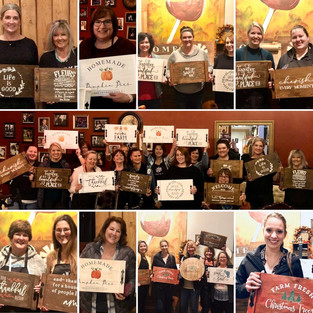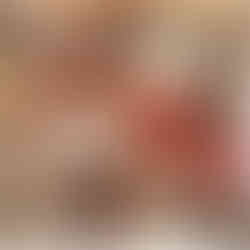Stenciling wood
- Claire
- Jul 21, 2020
- 4 min read
Updated: Jul 24, 2020
After years of teaching art classes, the one technique that fills a lot of people with uncertainty and dread is stencil work. While it can be tricky and can go horribly wrong, it should not put you off being creative and taking your projects to the next level! Worst case scenario? Sand it off and start over! But applying a stencil to wood, or any background for that matter, is actually a lot easier that it seems, if you have the right directions. Follow the steps below to take the intimidation factor out of the creative process and enjoy your newly-created hand made project!

To get started you'll need:
a stencil, reusable or one-time use
1 stencil brush/ make-up wedge per color
thick undiluted paint
1 paper plate
1 nail/ weeding or picking tool/ toothpick
your painted and fully dried wood, which could be a tray, a pallet sign, table, box or anything else you've bought or created. Make sure your project is completely dry. Any moisture will affect the finish of your stenciling and will cause the stencil to run and distort.
optional: masking tape
I have used a recent directional sign project with a one-time use stencil to demonstrate.

Your one-time use stencil has three parts:
1. A card stock type backing, which often has a grid or printing on it, such as "Cricut" or 'Oracal" etc.
2. A top layer, which is usually a fibrous white or clear film, which keeps your design parts together.
3. The middle layer, which is the actual design. This can be any color, but most often is black or bright blue. It is very adhesive on one side.
A re-usable stencil is made of thick vinyl, plastic or heavy card-stock, without the other two layers. It is typically not adhesive and you'll need masking tape to prevent it from moving. To see how to apply this type of stencil please see this post.

Before starting, position your stencil onto your project to see where it would look best- center/ corner/ top/ bottom.

Rub the grid side with a credit card, to make sure the design transfers to the top film. Then carefully and slowly peel away the grid layer. If part of the stencil design lifts with it, just lower the grid layer and rub the section a little more.
It helps to lay the stencil on a hard surface, rather than peeling away at it up in the air, in case it rolls back on itself like sellotape.

Place your stencil, sticky side down, onto your wood, making sure that it is evenly aligned. You can eyeball it or you can use a ruler to carefully measure from the edges of the board to the base of your lettering to ensure that your stencil is straight! While this seems like an annoying step, it'll be less work than having to sand off your art and start again, in case it's off-center!

Once your stencil is straight, gently trace the edges of the text or design with your finger to ensure a seal which will prevent paint from running under the stencil. Carefully remove the top layer. Again, if any of your design lifts with the removal of this layer, gently rub the part back onto the wood before continuing. Don't rub your stencil too hard, or it may damage the painted wood underneath.
If your design is cut close to the edge of the stencil, use masking tape to prevent you from painting over the edge onto the wood!

Using a stencil brush or sponge wedge, with a thick chalk-based paint, dab a thin first layer of paint to your design. Less is more. The less paint you use, the less chance there is of paint running under the stencil. Acrylic paint will work as well. Do not overload your sponge/ brush or your paint will run under the design.
Do not use any water for this step! Move away your glass of wine or cup of tea, to prevent inadvertent dipping!

After a first thin coat of paint, the wood grain is still visible. Always err on the side of caution and rather apply a few thin layers than one that is too thick. The first coat is the most critical. Once that has dried, it'll dam up the design edges for further coats.
Dry between coats.

After 2-3 light coats of paint, the coverage is sufficiently opaque.

Once the paint is dry, remove the stencil.
Use a nail/ toothpick/ picking or weeding tool to help you remove the finer parts of the stencil.
If your stencil has run, use the nail to scrape away at excess paint.

If your project will be exposed to moisture or weather, coat it with a sealant or varnish, to protect your work from weathering.
I have used non-yellowing Krylon, Rustoleum and Mod Podge products with success. They are available in sprays as well as liquid formats. If you use a spray, make sure you do so in a well ventilated area or outdoors. You can find these brands at hardware or craft stores.
It does take about 3 coats of spray varnish, with drying time in-between to sufficiently seal each board on all sides.
A glossy varnish will be easier to clean, for trays, tables and other functional art. Matte varnishes are great for a more rustic flair.
Now put up your feet and admire your work!
I hope you enjoyed this post and that your project turned out gorgeous! Please send feedback or share your work with tag #threeandme.
A few other stenciled projects:






















































Comments